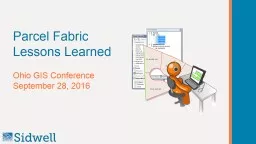

Lessons Learned Ohio GIS Conference September 28 2016 What is the Parcel Fabric A specialized grouping of core Arc feature classes Control Points Line Points Points Lines Polygons Parcel Lot ID: 544986
Download Presentation The PPT/PDF document "Parcel Fabric" is the property of its rightful owner. Permission is granted to download and print the materials on this web site for personal, non-commercial use only, and to display it on your personal computer provided you do not modify the materials and that you retain all copyright notices contained in the materials. By downloading content from our website, you accept the terms of this agreement.
Slide1
Parcel Fabric
Lessons Learned
Ohio GIS ConferenceSeptember 28, 2016Slide2
What is the Parcel Fabric?
A specialized grouping of core Arc feature classesControl Points
Line PointsPoints
Lines
Polygons (Parcel, Lot, etc…)Topological interactionEsri’s parcel editing solutionPart of the LGIM
Background
Parcel FabricSlide3
Benefits
COGO Based Workflows
Intuitive ‘Fitting’ WorkflowsDifferent Types of ‘Parcels’
Least Squares Adjustments
Historical ManagementAutomated Dimension PlacementArcGIS for Local GovernmentSupport (meetups / customer feedback)
Why it is Fantastic
³Slide4
Benefits for Ohio Tax Mappers
Deed Review
Review Legals using New Parcel
Deed Drafter
Don’t need Arc licenseCreates importable xml’sDrawing and saving for laterWhy it is FantasticSlide5
Implementation
Data Should be Super Clean Before Loading
Clean the densified arcsGaps and overlaps
Issues between different types
(sections/parcels)TopologyEsri provides great documentationon migrating dataForces you to clean data (not a bad thing!)
Things to NoteSlide6
Implementation
Migration
Staging databases (free from Esri)Multiple loads can be strategic
Don’t think you have to do it all at
onceDifferent types of featuresParcels a group at a timeThings to NoteSlide7
Implementation
Migration of Right-of-Ways
Value is in adjustments and distribution of errorBulk cutting can be laborious – use existing features (Centerlines, PLSS)
More simple features > less complex features
Load as Encumbrance (Pre ROW) or Lot (Public ROW)Things to NoteSlide8
Implementation
Performance
The parcel fabric is memory intensive Requires good server and database management
We have learned a lot especially with the larger datasets
Things to NoteSlide9
Implementation
Data Storage / Management
Load the parcel fabric into SDE Binary (if using SDE)Geometry can be used for published datasets
Fastest rendering speed
Make a habit of periodically rebuilding new spatial indexes – greatly improves performanceBest practice to schedule compress of geodatabaseThings to NoteSlide10
Implementation
Data Storage / Management
Replication does not work well with the parcel fabric – if needing to move edits:have to query by date/user
Export to xml
Append to fabricUse best practice database tuning (good DBA)Get used to not zooming to fullThings to NoteSlide11
Implementation
Editing Platform
The parcel fabric is an editing platform
Data should be published to layers for consumption
Publication workflows incorporated into platformGIS layer exportsPlottingWebsitesTHIS IS THE BASE!
Things to NoteSlide12
Implementation
Champions and Mappers
Investment in the greater good often overlooks the daily challenges of the mappersAside from the technological solutions is the investment in personnel to change the way they approach their work
Transitions
take timeSlide13
Implementation
Change in Mapping Technique
Less about the lines, more about the polygons
Drawing complete features outside of the mapping area before joining them
Less about the maps, more about the baseMaking things fit (large tracts)Software making assumptionsSlide14
Implementation
Topology/Corrections
No topology tools you are used to once you’re in the fabricCan export to detect gaps/overlaps
Zoom to fabric to fix them
Tools are very different to fix errorsTransform parcelsVertex/point managementLine PointsSlide15
Implementation
Subdivisions
COGO everything in one spreadsheet/traverse
Build all lots/subs/parcels from same lines
Challenge has been joining subs to existing bad data – more parts need to line up, and requires a different approachSlide16
Implementation
Unlearning old habits is much harder than starting from scratch
Like learning a foreign languageAlways comparing to the old workflow makes it more difficult to see the greater good
User that comes in fresh only knows one way to do itSlide17
Implementation
Learning is a long process
Its not so much learning what the tools do, but where the tools are and in what order to use them
Workflows
Support is importantInternally and externallySlide18
Case Studies – Fresno County
Transition
Non georeferenced Arc/INFO coverages to parcel fabricAdopting countywide workflows for first time
Plotting component
Big ChallengesArc/INFO Workstation is dying breedVery different workflows for mappersSlide19
Case Studies – Fresno County
Implemented the fabric on 300,000
parcelsAccuracy not so good
Long learning curve – champion left
Have got the small stuff downLarge tracts – catching them upMore stories…Butler County IA (15,000 parcels)
Future of ArcGIS Pro, etc.Slide20
THANK YOU
Van O’Brien| Director of Solutions and Services
St. Charles, IllinoisOffice: 630-549-1031| Cell: 815-762-6735www.sidwellco.com